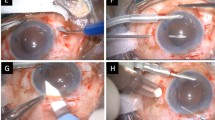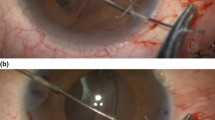Abstract
Purpose
To report a retrospective series of patients implanted with a novel hydrophilic acrylic single-piece intraocular lens (IOL) designed for sutureless scleral fixation (FIL-SSF Carlevale lens, Soleko, Italy) injectable through a 2.2-mm incision.
Methods
Seventy-eight patients with minimum 6-month follow-up were divided into 6 groups: dropped nucleus, luxated IOL, trauma, aphakia, IOL exchange, and Marfan’s syndrome. Surgery included peritomy and scleral flap creation at 3 and 9 o’clock position. The IOL was then injected and grasped with 25G forceps through a hole created 2 mm posterior to the limbus underneath the sculped scleral flap.
Results
The study included 78 patients (mean age 71.9 ± 12.6 years) and average follow-up 10.2 ± 4.2 months. Average surgery duration was 69.4 ± 26.1 min and vision significantly improved from 0.86 ± 0.56 logMAR to 0.38 ± 0.42 logMAR at 6 months post-operative (p < 0.001). Intraoperative complications included corneal edema, retinal tears, and vitreous bleeding each in 2/78 patients (2.5%); 1/78 (1.3%) localized retinal detachment and 1/78 (1.3%) rupture of one T-shaped IOL harpoon. Post-operative complications included 4/78 (5.1%) cystoid macular edemas, 2/78 retinal tears, 2/78 retinal detachments, 2/78 developed ocular hypertension, and 1/78 corneal decompensation requiring DSAEK.
Conclusion
The Carlevale lens is designed for sutureless intrascleral fixation and can be successfully used in a variety of indications including difficult trauma cases with good rehabilitation. An implant requires experience and delicate manipulation.



Similar content being viewed by others
References
Stem MS, Todorich B, Woodward MA, Hsu J, Wolfe JD (2017) Scleral-fixated intraocular lenses: past and present. J Vitreoretin Dis 1(2):144–152. https://doi.org/10.1177/2474126417690650
Moschos MM, Nitoda E (2016) The correction of aphakia using anterior chamber intraocular lens. In Vivo 30(6):733–738. https://doi.org/10.21873/invivo.10988
Hernández Martínez A, Almeida González CV (2018) Iris-claw intraocular lens implantation: efficiency and safety according to technique. J Cataract Refract Surg 44(10):1186–1191. https://doi.org/10.1016/j.jcrs.2018.06.049
Rabie HM, Esfandiari H, Rikhtegar MH, Hekmat V (2018) Management of sulcus-fixated single-piece intraocular lens-induced pigmentary glaucoma with 3-piece IOL exchange. Int Ophthalmol 38(1):145–150. https://doi.org/10.1007/s10792-016-0435-9
Nehme J, Sahyoun M, Saad M et al (2018) Secondary intraocular lens implantation with absence of capsular support: Scleral versus iris fixation. J Fr Ophtalmol 41(7):630–636. https://doi.org/10.1016/j.jfo.2017.11.029
Kelkar A, Kelkar J, Kothari A et al (2018) Comparison of two modified sutureless techniques of scleral fixation of intraocular lens. Ophthalmic Surg Lasers Imaging Retina 49(10):e129–e134. https://doi.org/10.3928/23258160-20181002-15
Chan TC, Lam JK, Jhanji V, Li EY (2015) Comparison of outcomes of primary anterior chamber versus secondary scleral-fixated intraocular lens implantation in complicated cataract surgeries. Am J Ophthalmol 159(2):221–6. e2. https://doi.org/10.1016/j.ajo.2014.10.016
Yoshida N, Kojima T, Yokoyama S, Horai R, Ichikawa K (2018) New surgical approach for intrascleral fixation using an intraocular lens with hook-shaped haptics. J Cataract Refract Surg 44(2):129–133. https://doi.org/10.1016/j.jcrs.2017.12.011
Yamane S, Sato S, Maruyama-Inoue M, Kadonosono K (2017) Flanged intrascleral intraocular lens fixation with double-needle technique. Ophthalmology. 124(8):1136–1142. https://doi.org/10.1016/j.ophtha.2017.03.036
Yavuzer K, Evcimen Y (2019) Sutureless transconjunctival intrascleral intraocular lens fixation: the modified Yamane technique. Arq Bras Oftalmol 82(5):389–393. https://doi.org/10.5935/0004-2749.20190072
Narang P, Agarwal A (2019) Handshake riveting flanged technique for Yamane method of intrascleral fixation of an intraocular lens. J Cataract Refract Surg 5(12):1838–1839. https://doi.org/10.1016/j.jcrs.2019.09.014
Chee SP, Chan NS (2018) Suture snare technique for scleral fixation of intraocular lenses and capsular tension devices. Br J Ophthalmol 102(10):1317–1319. https://doi.org/10.1136/bjophthalmol-2018-311868
John T, Tighe S, Hashem O, Sheha H (2018) New use of 8-0 polypropylene suture for four-point scleral fixation of secondary intraocular lenses. J Cataract Refract Surg 44(12):1421–1425. https://doi.org/10.1016/j.jcrs.2018.08.008
Helvaci S, Demirduzen S, Oksuz H (2016) Iris-claw intraocular lens implantation: anterior chamber versus retropupillary implantation. Indian J Ophthalmol 64(1):45–49. https://doi.org/10.4103/0301-4738.178139
Yazdani-Abyaneh A, Djalilian AR, Fard MA (2016) Iris fixation of posterior chamber intraocular lenses. J Cataract Refract Surg 42(12):1707–1712. https://doi.org/10.1016/j.jcrs.2016.10.008
Kunishige T, Takahashi H (2020, 2019) Comparison of initial experience with two different intrascleral intraocular lens fixation techniques [published online ahead of print, 2019 Dec 27]. J Nippon Med Sch. https://doi.org/10.1272/jnms.JNMS.2020_87-304
Zayed MG, Winder S (2014) Iris chafing syndrome after scleral-fixated intraocular lens implantation. J Cataract Refract Surg 40(11):1927–1928. https://doi.org/10.1016/j.jcrs.2014.09.019
Yang JM, Yoon KC, Ji YS (2015) Transscleral fixation of single-piece foldable acrylic lens with eyelets at the optic-haptic junction. Can J Ophthalmol 50(5):367–372. https://doi.org/10.1016/j.jcjo.2015.07.006
Yamane S, Inoue M, Arakawa A, Kadonosono K (2014) Sutureless 27-gauge needle-guided intrascleral intraocular lens implantation with lamellar scleral dissection. Ophthalmology. 121(1):61–66. https://doi.org/10.1016/j.ophtha.2013.08.043
Rossi T, Querzoli G, Angelini G et al (2014) Introducing new vitreous cutter blade shapes: a fluid dynamics study. Retina. 34(9):1896–1904. https://doi.org/10.1097/IAE.0000000000000143
Veronese C, Maiolo C, Armstrong GW et al (2020) New surgical approach for sutureless scleral fixation [published online ahead of print, 2020 Jan 30]. Eur J Ophthalmol 2020:1120672120902020. https://doi.org/10.1177/1120672120902020
Barca F, Caporossi T, de Angelis L, Giansanti F, Savastano A, Di Leo L, Rizzo S (2020) Sutureless scleral fixation using Carlevale lens; surgical and refractive outcomes. J Cataract Refract Surg. https://doi.org/10.1097/j.jcrs.0000000000000135
Acknowledgments
The authors would like to thank the Fondazione Roma for support.
Author information
Authors and Affiliations
Contributions
T. Rossi: manuscript writing and study design; D. Iannetta: data search, proof reading, and study design; V. Romano: data search and manuscript writing; C. Carlevale: manuscript writing and proof reading; M. Forlini: data search and proof reading; S. Telani: data search and proof reading; A. Imburgia: data search; A. Mularoni: manuscript writing and proof reading; L. Fontana: manuscript writing and proof reading; and G. Ripandelli: data search and proof reading.
Corresponding author
Ethics declarations
Conflict of interest
All authors with the exception of Carlo Carlevale certify that they have no affiliations with or involvement in any organization or entity with any financial interest (such as honoraria; educational grants; participation in speakers’ bureaus; membership, employment, consultancies, stock ownership, or other equity interest; and expert testimony or patent-licensing arrangements), or non-financial interest (such as personal or professional relationships, affiliations, knowledge or beliefs) in the subject matter or materials discussed in this manuscript. Carlo Carlevale receives speaker honorarium from Soleko srl but does not own stock in Soleko, neither is a member of any committee related to this IOL commercialization.
Statement of ethics
Present research complies with the guidelines for human studies and was conducted ethically in accordance with the World Medical Association Declaration of Helsinki. Informed consent was obtained by patients involved in the study.
Additional information
Publisher’s note
Springer Nature remains neutral with regard to jurisdictional claims in published maps and institutional affiliations.
Electronic supplementary material
Rights and permissions
About this article
Cite this article
Rossi, T., Iannetta, D., Romano, V. et al. A novel intraocular lens designed for sutureless scleral fixation: surgical series. Graefes Arch Clin Exp Ophthalmol 259, 257–262 (2021). https://doi.org/10.1007/s00417-020-04789-3
Received:
Revised:
Accepted:
Published:
Issue Date:
DOI: https://doi.org/10.1007/s00417-020-04789-3




